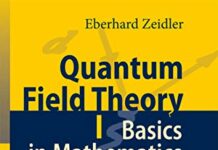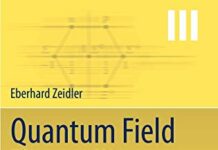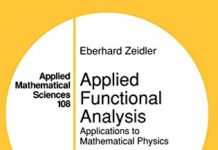
Ebook Info
- Published: 2009
- Number of pages: 1138 pages
- Format: PDF
- File Size: 11.50 MB
- Authors: Eberhard Zeidler
Description
And God said, Let there be light; and there was light. Genesis 1,3 Light is not only the basis of our biological existence, but also an essential source of our knowledge about the physical laws of nature, ranging from the seventeenth century geometrical optics up to the twentieth century theory of general relativity and quantum electrodynamics. Folklore Don’t give us numbers: give us insight! A contemporary natural scientist to a mathematician The present book is the second volume of a comprehensive introduction to themathematicalandphysicalaspectsofmodernquantum?eldtheorywhich comprehends the following six volumes: Volume I: Basics in Mathematics and Physics Volume II: Quantum Electrodynamics Volume III: Gauge Theory Volume IV: Quantum Mathematics Volume V: The Physics of the Standard Model Volume VI: Quantum Gravitation and String Theory. It is our goal to build a bridge between mathematicians and physicists based on the challenging question about the fundamental forces in • macrocosmos (the universe) and • microcosmos (the world of elementary particles). The six volumes address a broad audience of readers, including both und- graduate and graduate students, as well as experienced scientists who want to become familiar with quantum ?eld theory, which is a fascinating topic in modern mathematics and physics.
User’s Reviews
Reviews from Amazon users which were colected at the time this book was published on the website:
⭐A Bridge Over Troubled WaterProfessor Eberhard Zeidler has set upon himself the monumental task of uniting mathematics and physics, thereby building a bridge between two “enemy” ommunities. This is as difficult an undertaking as Shakespeare’s attempt to unite two lovers, and thereby create a bridge between their feuding families. The reason is that Zeidler’s task, like Shakespeare’s, is beset with certain inherent difficulties and contradictions.Mathematics, and mathematical education, start with a contradiction. By its very technical nature, mathematics is divided into various compartments and sub-compartments. Yet, to my knowledge, no other field is more united and inseparable than mathematics. Even physics can be divided into somewhat independent fields, but mathematics cannot. This makes math unique among all branches of human knowledge.Soft fields like literature and history are very loosely bound. You can start with any author, like Shakespeare, Sartre, or Steinbeck, or any historical period, like British, Indian, or America history, and from there you can continue in any direction you want like a free bird. You can’t do that in maths. You have to begin at a very specific point, 1,2,3,… and follow a very tightly bound order – just try to teach calculus to a guy who doesn’t know trigonometry. In other words, soft fields like literature are like beautiful cities – you can visit their attractions in any order you want. But mathematics is like a maze or labyrinth – you have only one entry point, and once inside and in panic, you are forced to chase every nook and corner to reach for the exit before you go mad. This is the agony and the ecstasy of mathematics.Now enters physics on this “murky and stormy” stage. Again there are inherent differences in the approach of mathematicians and physicists to their respective fields. The most important thing in mathematics is a proof. In fact, I could not justify a lot of “weird” ideas in mathematics till I read their proofs. Often it is the necessity of proving things that introduces a lot of “weird” and counter-intuitive notions in math (at least for me).Recently proofs in mathematics have become longer and longer. Many of Harish-Chandra’s proofs in semi simple Lie groups and algebras are more that 100 pages long. Wiles proof of Fermat theorem is more than 200 pages long. And the Classification Theorem of finite groups requires more than 5000 pages of proof. As a physicists I have not even tried to read those proofs – I am incapable of that. But in my opinion a logical question arises:Have these proofs to be so long, and if so, why? Do they reflect the strength or the weakness of the human mind?I personally believe this is a fundamental question, and its very answer – whatever it may be – will clarify further the nature of mathematics, and even more , it would “throw some light” on the relationship between math and physics.Now to physics.Physics is all about Nature. And mathematics is just a language used to explain Nature. The relation between mathematics and physics is that of poetry and the language used to express that poetry. There is no inherent relation. This means that math and physics are not tightly bound, just as poetry is not bound to any specific language. Shakespeare could have used any language to express the same beautiful thoughts. And if it ever turns out that extraterrestrials have a better language to explain Nature I for one would rush to master it and throw our terrestrial mathematics into the dust-bin. This hints at a mismatch between math and physics.One of the differences between physics and mathematics is that physics is more intuitive, and long mathematical proofs won’t help if the intuition is not there. In fact, physics is a reality-check on math – it controls maths runaway flights into pure logic. I guess this is what Einstein and Feynman always said. And it is exactly here that a lot of bridges between math and physics have collapsed. Probably the mismatch lies in the brains of mathematicians and physicists. So, paradoxically again, in order to build true bridges between math and physics, some psychological study of the minds of mathematicians and physicists is needed. This gives some indication of the difficulty of building these bridges. It is not a bilateral but a multilateral task – a sort of multidisciplinary study. Seeing that Prof. Zeidler needs 6000 pages to deal with this bilateral task alone, it is no wonder that people dare not plunge into the murky waters of multilateralism – bilateralism is dark enough a territory to mess with.The reason I am excited about “Zeidler Program” is that almost every time I read something from the 2 volumes of his series, I end up seeing some connection between physics and math which I did not see before, and thissets me “thinking” ( at least in my limited ways). This cannot be said of many other books where all you can do is stare at the “most general formalism expressed in extremely terse notation”. All you can carry away from such “masterpieces” is pseudo-knowledge consisting of some memorized terms and this is the most dangerous form of knowledge.Yet the reason I am not passing a technical judgement on the first 2 volumes of his program is that I want to wait till volume 3 (Gauge theory) and volume 4 (Quantum Mathematics) appear on the stage. They will be the making or breaking points of “Zeidler Program”. Only they will demonstrate what kind of bridges he has built between poor, old, and senile Electromagnetism and his new, flashy, and rich cousin called Principal Fiber Bundle, and between a man called Witten and a man called Witten again, that is, between Witten the physicist and Witten the mathematician. It is over such troubled waters that many a bridges have been washed away in the past. So I wish Prof. Zeidler all luck.To be continued after the appearance of volumes 3 and 4……Rattan MannOslo, Norway
⭐My background in math and physics is not good enough to do a good review of this book. It looks at QED from a big picture point of view which I like. He probably does a good job of it, I’m not in a position to say. I hope someone will come along soon who can do a better job of reviewing the good parts of the book.My concern is that at the page level, it has a lot of problems. There are a large number of typos, sometimes in strategic places. I suppose that can’t be helped. However, there is at least one definition that is simply incorrect. Fortunately, that becomes obvious right away. Although Schwartz spaces and tempered distributions are used in several places, they are not defined at all. Instead it refers you to the definition in volume I which I don’t have. On the other hand, the Heaviside function is defined five times. Some of the definitions of mathematical objects are ambiguous, obviously not written by a mathematician for a mathematician. I presume that Professor Zeidler’s native language is German, and while his English is quite good, it is not quite good enough for this book. He practially says as much himself. An intersting, but unimportant side-note: in one place I found the word ‘und’, where ‘and’ was meant. The notation is inconsistent from chapter to chapter, sometimes changing within a page and in at least one case changing in mid-sentence. It seems that whereever there is a similarity of ideas in two places, there lacks a corresponding similarity of presentation.Some things I like about the book. Not every proof is given in the book. Instead, a citation is given to where the proof can be found in another book. This allows the author to cover more ground and the reader to choose whether or not to find the proof. I haven’t been looking up these proofs myself. I hope that the diligent reader doesn’t need an entire library to complete the proofs. A large range of mathematics is presented. Even if you don’t learn any physics, you will learn a lot of math by reading this book. What is more, you will have physical motivation for the mathematics. I think this helps to understand the meaning behind the abstraction.
⭐I’m sorry I was late.The goods were well received. Thank you.
⭐Good.
Keywords
Free Download Quantum Field Theory II: Quantum Electrodynamics: A Bridge between Mathematicians and Physicists 2009th Edition in PDF format
Quantum Field Theory II: Quantum Electrodynamics: A Bridge between Mathematicians and Physicists 2009th Edition PDF Free Download
Download Quantum Field Theory II: Quantum Electrodynamics: A Bridge between Mathematicians and Physicists 2009th Edition 2009 PDF Free
Quantum Field Theory II: Quantum Electrodynamics: A Bridge between Mathematicians and Physicists 2009th Edition 2009 PDF Free Download
Download Quantum Field Theory II: Quantum Electrodynamics: A Bridge between Mathematicians and Physicists 2009th Edition PDF
Free Download Ebook Quantum Field Theory II: Quantum Electrodynamics: A Bridge between Mathematicians and Physicists 2009th Edition


